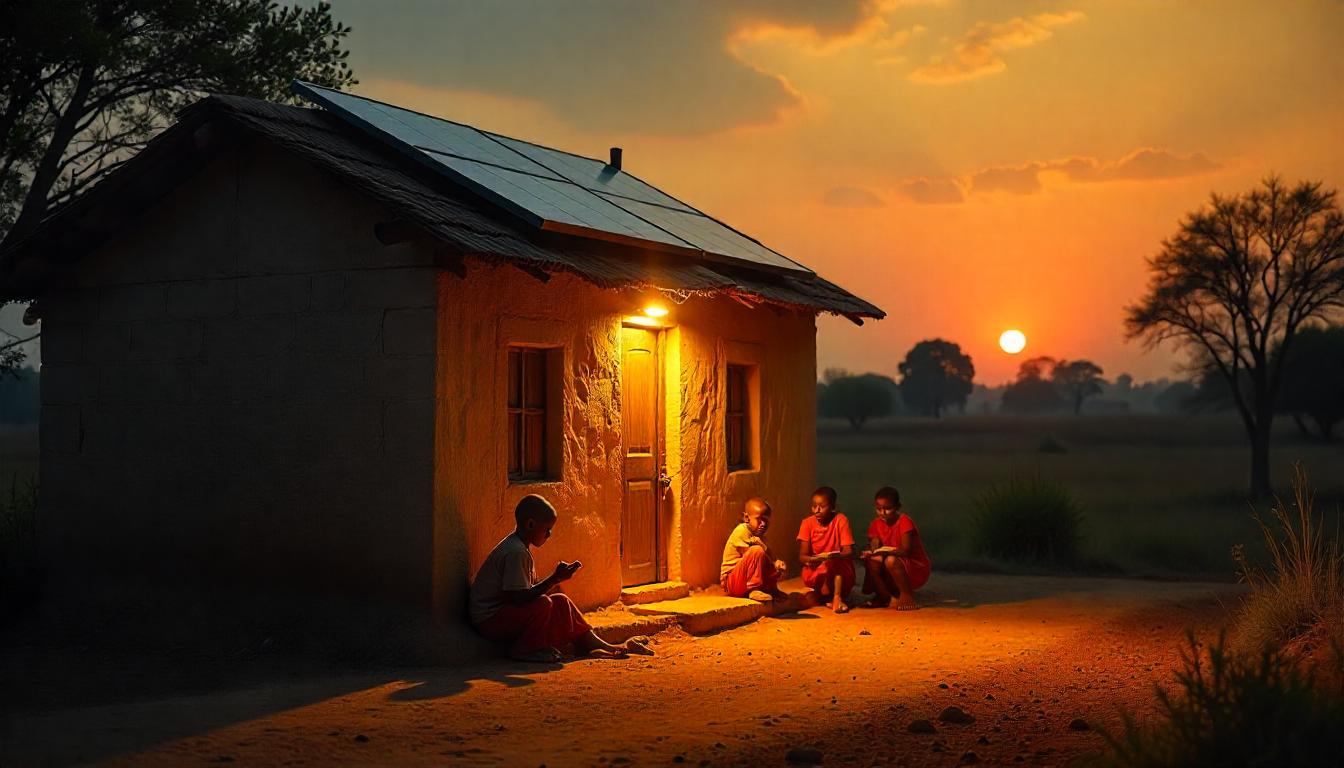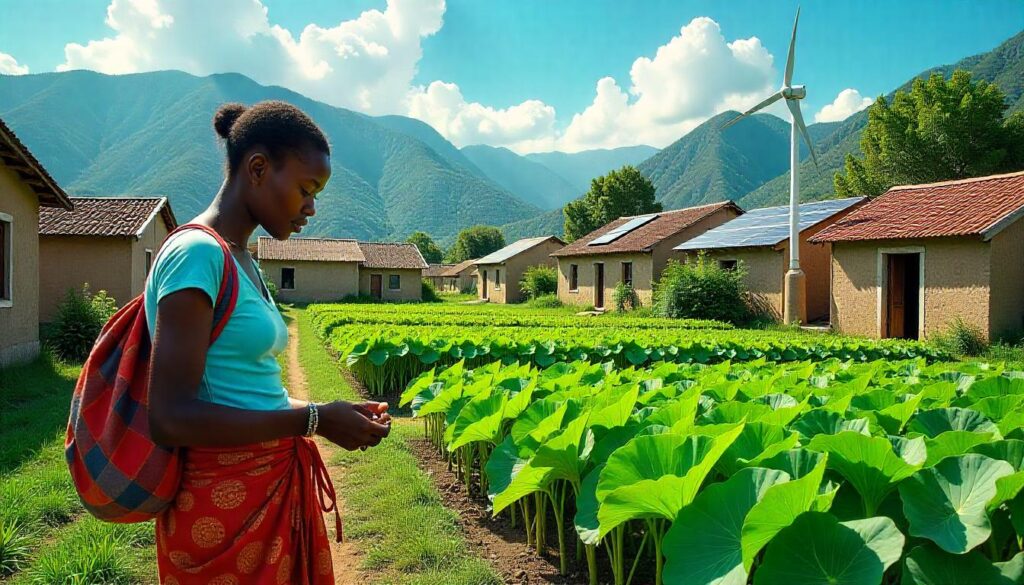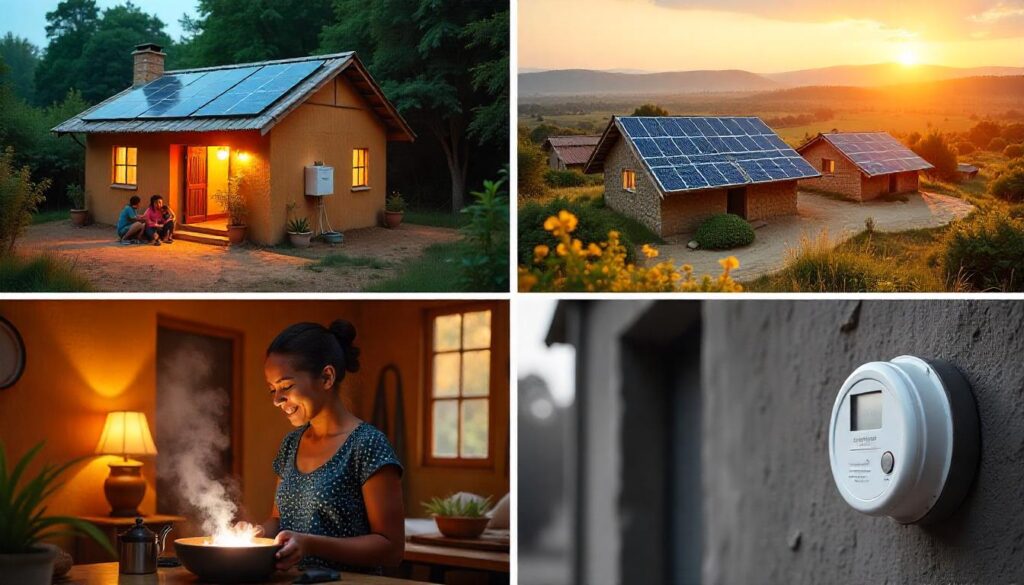Bridging the Energy Gap: Why Green Solutions Are Key for Developing Nations

Bridging the Energy Gap: Why Green Solutions Are Key for Developing Nations
Imagine a world where studying after dusk is impossible, where vital medicines spoil due to lack of refrigeration, or where the simple act of cooking dinner fills homes with toxic fumes. This is the stark reality for hundreds of millions facing energy poverty—a silent crisis impacting lives across the globe, most acutely in developing nations. While much of the industrialized world enjoys abundant, reliable power, a significant portion of humanity remains disconnected from modern energy services.
This disparity creates a profound “energy gap”—a” critical shortfall in access to reliable, affordable, and clean energy. This isn’t just an inconvenience; it’s a fundamental barrier to human development, economic growth, and environmental sustainability. This article will argue that green energy solutions are not merely an alternative but the only truly viable and sustainable path to achieving universal energy access in developing countries. We will explore why these innovative approaches are uniquely suited to overcome historical challenges, offering a direct route to economic empowerment, improved health outcomes, and environmental protection, paving the way for a brighter, more equitable future.
- Bridging the Energy Gap: Why Green Solutions Are Key for Developing Nations
- 1. The Devastating Reality of Energy Poverty: Why Access Matters
- 2. The Limitations of Traditional Grids: Why Conventional Solutions Fall Short
- 3. Green Solutions: The Blueprint for Bridging the Gap
- 4. Empowering Communities: Key Green Energy Technologies in Action
- 5. Overcoming Hurdles: Financing, Policy & Capacity Building
- Conclusion: A Brighter, Sustainable Future for All
- Frequently Asked Questions (FAQs) About Green Energy & Developing Nations
1. The Devastating Reality of Energy Poverty: Why Access Matters
Energy poverty signifies the absence of access to modern energy services, encompassing both electricity and clean cooking fuels/technologies. Its scale is staggering, and its impacts are profound.
Globally, approximately 685 million people lacked electricity access in 2022, according to the World Health Organization (WHO), a concerning increase for the first time in over a decade, largely due to population growth outpacing new connections. Over 80% of these individuals—around 570 million—reside in sub-Saharan Africa. Even more sobering, 2.1 billion people still rely on polluting fuels like wood, charcoal, animal dung, and kerosene for cooking. This contributes to a staggering 3.2 million premature deaths annually from indoor air pollution, a silent killer far more deadly than many common diseases.
The ramifications of this energy gap extend far beyond basic illumination:
- Health: Beyond indoor air pollution, lack of reliable power hinders the refrigeration of medicines, limits access to essential medical equipment, and compromises the operation of health clinics.
- Education: Without reliable lighting, children cannot study after dark, perpetuating cycles of illiteracy and limiting access to digital learning tools.
- Economic Development: Lack of power severely limits productivity and income generation. It stifles the growth of micro-enterprises, prevents the mechanization of agriculture (e.g., irrigation, food processing), and reduces opportunities for economic diversification.
- Gender Equality: Women and girls disproportionately bear the burden of energy poverty, spending countless hours (up to 40 hours per week in some areas) gathering fuelwood, sacrificing educational and income-generating opportunities, and facing increased safety risks.
- Environmental Degradation: Over-reliance on traditional biomass for energy leads to rampant deforestation, land degradation, and increased greenhouse gas emissions.
This pervasive lack of energy access in developing countries is a humanitarian crisis, directly impeding progress towards almost all of the UN’s Sustainable Development Goals.

2. The Limitations of Traditional Grids: Why Conventional Solutions Fall Short
For decades, the standard approach to electrification was extending centralized power grids. However, this model often proves inadequate and unsustainable for addressing widespread energy poverty in developing nations, particularly in remote and rural areas.
The primary hurdle is the prohibitive cost of infrastructure. Extending centralized grids to sparsely populated or geographically challenging rural communities requires massive investments in poles, wires, transformers, and substations. The sheer expense of these civil works makes it economically unviable for utilities to connect distant, low-density populations, especially when the potential revenue from low-income households is minimal. Even if the grid theoretically “reaches,” high connection fees and ongoing tariffs often create an affordability gap that leaves many unable to pay for access, perpetuating energy poverty.
Beyond cost, traditional grids in remote areas face significant maintenance and reliability challenges. Long transmission lines are prone to frequent outages due to weather, theft, or technical faults, and repairs in remote locations are costly and time-consuming, leading to unreliable power supply. Furthermore, energy loss over vast distances through transmission lines is substantial, making distant electrification inefficient.
This centralized model also creates a single point of failure, leaving entire regions vulnerable to blackouts from technical glitches, natural disasters, or even political instability. It’s clear that a new, more adaptable paradigm is needed for rural electrification.

3. Green Solutions: The Blueprint for Bridging the Gap
In stark contrast to the limitations of traditional grids, green energy solutions offer a uniquely viable and sustainable blueprint for achieving universal energy access in developing countries. They are not merely an alternative; they represent the optimal path forward.
The fundamental advantage lies in their decentralized nature. Technologies like solar PV, small hydropower, wind, and biomass can be deployed locally, at the point of consumption, eliminating the need for costly and extensive grid extensions. This makes them perfectly suited for off-grid energy solutions in remote villages and scattered communities, directly addressing the core challenge of rural electrification.
Developing nations are often blessed with abundant local renewable resources. Vast stretches of sun-drenched land, consistent wind patterns, numerous small rivers, and agricultural waste for biomass are readily available. Tapping into these indigenous resources reduces reliance on volatile and expensive imported fossil fuels, bolstering national energy security and fostering local economic independence.
Crucially, the global landscape for green energy has been revolutionized by falling costs. The dramatic decrease in the price of solar photovoltaic (PV) panels and battery storage over the past decade has made these technologies increasingly affordable, often costing less over their lifecycle than diesel generators, especially in remote areas where fuel transport costs are high.
Beyond economic viability, the environmental benefits are profound. Deploying green energy directly contributes to climate change mitigation by significantly reducing greenhouse gas emissions. It also drastically improves local air quality and public health by replacing polluting fuels used for lighting and cooking.
Moreover, green energy catalyzes myriad socio-economic benefits:
- Job Creation: Local opportunities arise in the installation, maintenance, and operation of renewable energy systems.
- Economic Empowerment: Reliable power fuels small businesses, enhances agricultural productivity (e.g., powering irrigation pumps, food processing), and supports cold storage facilities.
- Health & Education: Electricity powers health clinics, enables refrigeration for vaccines and medicines, and provides reliable lighting for evening study, transforming educational outcomes.
- Energy Security: Reducing reliance on imported fossil fuels makes communities less vulnerable to global price fluctuations and supply disruptions.

4. Empowering Communities: Key Green Energy Technologies in Action
The promise of green energy solutions is already being realized through a variety of innovative technologies deployed in developing countries, bringing light and opportunity to communities that traditional grids could never reach.
- Solar Home Systems (SHS): These individual, household-level solar panels coupled with battery storage provide basic electricity for lighting, phone charging, radios, and small appliances. They are ideal for scattered homes and can be deployed rapidly. Companies like M-Kopa Solar in Kenya pioneered highly successful “pay-as-you-go” (PAYG) models, making SHS affordable for millions of low-income households by treating energy as a service rather than a large upfront purchase.
- Mini-Grids: For denser rural communities or small towns, mini-grids offer a more comprehensive solution. These are small-scale electricity networks powered by local renewable sources (primarily solar PV, often combined with battery storage, small hydro, or biomass gasifiers), serving a cluster of homes, businesses, and public services. Mini-grids provide higher power quality and quantity than SHS and are capable of running productive loads. In Cambodia, solar-based mini-grids are offering reliable, affordable energy solutions in hard-to-reach villages where conventional grid extension isn’t feasible, as highlighted by UNDP reports.
- Clean Cooking Solutions: Addressing the crisis of indoor air pollution, these solutions replace traditional biomass with healthier alternatives. Technologies include improved biomass cookstoves (which burn fuel more efficiently), biogas digesters (converting organic waste into cooking gas), LPG, and increasingly, electric cooking powered by expanding renewable energy access.
- Hybrid Systems: To enhance reliability and overcome intermittency, many green energy projects combine multiple renewable sources (e.g., solar and wind) or integrate limited diesel generator backup for critical loads, creating a more robust and resilient power supply.
Success stories abound, demonstrating the transformative impact of these solutions. India’s Saubhagya Program achieved near-universal household electrification by 2019, leveraging both grid extension and extensive off-grid solar solutions. Bangladesh reached universal electricity access in 2023, largely propelled by its massive adoption of Solar Home Systems. Ethiopia’s Universal Electrification Access Program (UEAP) successfully expanded grid access and promoted off-grid solar, connecting thousands of rural villages. These examples underscore the effectiveness and scalability of decentralized off-grid energy solutions.

5. Overcoming Hurdles: Financing, Policy & Capacity Building
Despite their immense potential, scaling green energy solutions in developing nations faces significant hurdles that require concerted effort and strategic intervention.
- Key Challenges:
- Financing: High upfront costs remain a barrier for many households and developers. Perceived risks for investors (e.g., political instability, regulatory uncertainty, currency fluctuations) limit private capital flow. Local financial institutions often lack the expertise or appetite for renewable energy projects.
- Policy & Regulatory Hurdles: Inconsistent or absent national energy policies, bureaucratic complexities, and a lack of clear, long-term energy access goals can deter investment and slow deployment.
- Technical Capacity: A shortage of local skilled labor for the installation, operation, and maintenance of advanced green technologies can impede project sustainability.
- Community Engagement: Ensuring genuine local ownership and understanding of new technologies is crucial to prevent abandonment and ensure long-term success.
- Strategic Enablers & Solutions:
- Innovative Financing Models: The widespread adoption of pay-as-you-go (PAYG) schemes has revolutionized affordability. Further leveraging results-based financing, green bonds, public-private partnerships, and integrating microfinance can unlock substantial capital.
- Supportive Policy Frameworks: Governments must implement clear and consistent renewable energy targets, streamlined permitting processes, and effective incentives like feed-in tariffs to attract investment.
- Capacity Building & Local Ownership: Investing in comprehensive training programs for local technicians, fostering local entrepreneurship, and empowering communities to manage their own mini-grids are vital for self-sufficiency.
- International Support: Continued financial aid, technical expertise, and policy guidance from international organizations like the World Bank, UNDP, IRENA, and bilateral development partners are indispensable for de-risking investments and accelerating deployment. Their expertise helps shape effective renewable energy policy and provide crucial seed funding.
Conclusion: A Brighter, Sustainable Future for All
The persistent energy gap in developing countries is undoubtedly a complex challenge, but one that green energy solutions are uniquely positioned to address. By embracing decentralized, affordable, and sustainable technologies, these nations can bypass the pitfalls of traditional, fossil-fuel-dependent models. They have the unparalleled opportunity to leapfrog directly into a more resilient, distributed, and environmentally friendly energy future.
This journey is not just about kilowatts and megawatt-hours; it’s about justice, equity, and unleashing the full human potential of billions. It’s about ensuring every child can study, every clinic can operate, and every small business can thrive. We strongly urge governments, international organizations, private investors, and local communities to prioritize and scale up investments in decentralized green energy.
The time is now to accelerate this transition. By collectively embracing this green energy revolution, we can help build a world where clean, affordable energy lights every home, powers every school, and fuels every enterprise. The future for energy access in developing countries is not just about filling a gap; it’s about illuminating the path to a brighter, more sustainable, and prosperous world for all.
Frequently Asked Questions (FAQs) About Green Energy & Developing Nations
- Q: What is energy poverty in the context of developing countries?
- A: Energy poverty refers to the lack of access to modern energy services, including reliable electricity and clean cooking fuels/technologies. It primarily affects rural and low-income populations in developing nations.
- Q: How many people lack electricity access globally?
- A: According to the WHO (2022 data), approximately 685 million people globally lacked electricity access, with over 80% of them residing in Sub-Saharan Africa.
- Q: Why are traditional power grids not ideal for rural electrification in developing nations?
- A: Traditional grids are often too expensive to extend to remote, sparsely populated rural areas; face high energy losses over long distances; suffer from reliability issues; and can be unaffordable for low-income households even if connections are available.
- Q: What are the main benefits of green energy solutions for developing countries?
- A: Green energy offers decentralized power, utilizes abundant local resources, has falling costs, provides significant environmental benefits (reduced emissions, cleaner air), creates local jobs, and improves health, education, and economic opportunities within communities.
- Q: What are some examples of successful green energy technologies used for rural electrification?
- A: Key technologies include Solar Home Systems (SHS) for individual homes (e.g., M-Kopa in Kenya), mini-grids for powering entire communities (e.g., in Cambodia), and various clean cooking solutions to replace polluting biomass.



